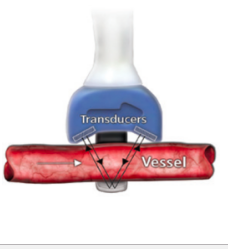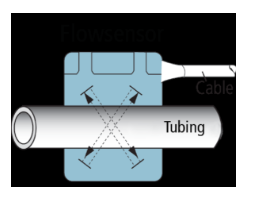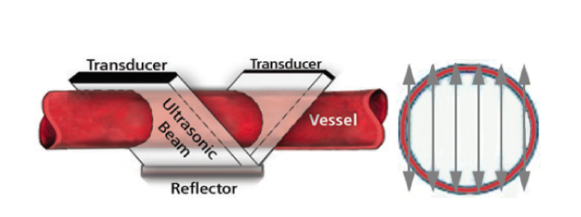Doppler Velocity Flow Measurement vs. Transit-time Volume Flow Measurement: How They Differ
When choosing a flow measurement option for an OEM device, it’s helpful to understand the differences between Doppler velocity measurements and Transit-time volume flow measurement.
Transit-time ultrasound devices directly measure volume flow in mL/min or L/min, while Doppler ultrasound looks inside a tube or vessel to measure average velocity. How do they differ and which provides superior results? Let’s take a look.
Doppler Flow vs. Transit-time Volume Flow:
Doppler Flow: Doppler derives flow from separate estimates of average velocity in cm/sec across a chord or inside a tubing cross-sectional area. Doppler measures average speed by bouncing signals off moving particles so particulate matter is required within a fluid to measure its velocity.
 A pen-tip Doppler probe “looks” at the flow velocity under the angle between the pen-tip and the vessel. If this angle changes from 45º to 60º, the relative flow velocity drops 30% from 71% of true forward flow velocity to 50%. To make a reasonable measurement, the angle of the pen-tip Doppler probe with the vessel would have to be controlled.
A pen-tip Doppler probe “looks” at the flow velocity under the angle between the pen-tip and the vessel. If this angle changes from 45º to 60º, the relative flow velocity drops 30% from 71% of true forward flow velocity to 50%. To make a reasonable measurement, the angle of the pen-tip Doppler probe with the vessel would have to be controlled.
Doppler flow measurements readings are also unreliable because high velocities can occur despite low flows. Doppler measurements cannot distinguish between normal diameter flows and flows at a Grade IV stenosis.
Transit-time Volume Flow:
Transit-time ultrasound technology looks through a cross section of a tube or vessel and measures the average displacement or phase shift of the fluid in the vessel and does not rely on particulates in the fluid.
 Volume Flow = Time Average Displacement
Volume Flow = Time Average Displacement
Transducers pass ultrasonic signals back and forth through a vessel alternately intersecting it in upstream and downstream directions. The “transit time” it takes for waves of ultrasound to travel from one transducer to the other are measured. The difference between upstream and downstream integrated transit times is a measure of volume flow.
Upstream Transit-Time Measurement Cycle
An electrical excitation causes the downstream transducer to emit a plane wave of  ultrasound. This ultrasonic wave intersects the tubing under study in the upstream direction, then bounces off the transducer on the opposite side of the tubing, again intersects the tubing and is received by the upstream transducer where it is converted into electrical signals. From these signals, the flowmeter derives an accurate measure of the “transit time” it took for the wave of ultrasound to travel from one transducer to the other.
ultrasound. This ultrasonic wave intersects the tubing under study in the upstream direction, then bounces off the transducer on the opposite side of the tubing, again intersects the tubing and is received by the upstream transducer where it is converted into electrical signals. From these signals, the flowmeter derives an accurate measure of the “transit time” it took for the wave of ultrasound to travel from one transducer to the other.
Downstream Transit-Time Measurement Cycle
The same transmit-receive sequence is repeated, but with the transmitting and receiving functions of the transducers reversed so that the flow under study is bisected by an ultrasonic wave in the downstream direction.
Just as the speed of a swimmer depends, in part, on water currents, the transit time of ultrasound passing through a tubing is affected by the motion of liquid flowing through that vessel. During the upstream cycle, the sound wave travels against flow and total transit time is increased by a flow-dependent amount. During the downstream cycle, the sound wave travels with flow and total transit time is decreased by the same flow-dependent amount. The Transonic flowmeter subtracts the downstream transit time from the upstream transit time utilizing wide-beam ultrasonic illumination. This difference of integrated transit times is a measure of volume flow.

Wide Beam Illumination
One ray of the ultrasonic beam undergoes a phase shift in transit time proportional to the average velocity of the liquid times the path length over which this velocity is encountered. With wide-beam ultrasonic illumination, the receiving transducer sums (integrates) these velocity - chord products over the vessel’s full width and yields volume flow. Since the transit time is sampled at all points across the tubing diameter, volume flow measurement is first- order independent of the flow velocity profile.
Doppler Flow vs. Transit-time Volume Flow: Which is Superior?
For applications where volume flow accuracy is required, transit-time flow measurement is the superior measurement option. Transit-time flow measurements can also accurately identify the presence of flow limiting stenosis or occlusions. Doppler measurements do have value in certain surgical protocols, for example, where a particular location of a stenosis needs to be identified or to identify remaining flows in incorrectly clipped aneurysms. However, for tubing flow measurements and perivascular measurements, due to the high reproducibility, wide beam integration and lack of sensitivity to misalignment, volume flow is most accurately measured by transit-time ultrasound.



